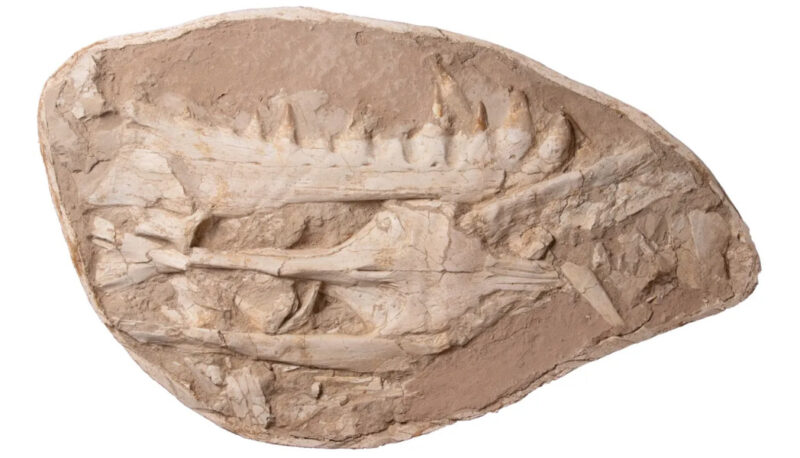Scientists have discovered a sea monster that once roamed the Atlantic Ocean off the coast of Morocco. During the time of the dinosaurs, the world’s oceans had a much wider range of giant predators, and the newly found Khinjaria acuta was certainly one of them.
It belongs to a family of huge lizards called the Mosasaurs. Despite its saurian name, it was not a dinosaur but related to modern Komodo dragons and anacondas. The meter-long skull suggests it had very small eyes and a short face. Researchers said that the “nightmarish” creature had huge, dagger-like teeth and was seven to eight meters long — larger than the largest crocodile ever recorded. Sixty-six million years ago, it shared its Atlantic waters with an astonishing array of other giant predators.

Khinjaria acuta fossil. Photo: Nick Longrich
its discovery is interesting not just because it is a new species, but because it shows how diverse the predators were in that era.
The extinct lizard’s teeth particularly intrigued the researchers. “We have multiple species growing larger than a great white shark, and they’re top predators, but they all have different teeth. It suggests they hunted in different ways,” said Dr. Nick Longrich, who led the study.
Depending on their shape, mosasaur teeth could, cut, tear, or crush prey. “The elongation of the posterior part of the skull…suggests a terrible biting force,” said co-author Natahalie Bardet about this new species.
Dagger-sharp
Its teeth even inspired its scientific name. Khinjar is Arabic for “dagger,” and acuta is Latin for “sharp.”
All these predators seem to have co-existed just before the dinosaurs and many marine reptiles, including the mosasaurs, went extinct.
“There seems to have been a huge change in the ecosystem structure in the past 66 million years,” said Longrich. “This incredible diversity of top predators in the Late Cretaceous is unusual, and we don’t see that in modern marine communities.”

Illustration of Khinjaria acuta skull. Image: Nick Longrich
Nowadays, far fewer species are apex predators, and most of those that remain are much smaller. Major ocean predators are sharks or marine mammals such as whales, dolphins, and seals, but they tend to feed on relatively small prey. Great white sharks and orcas are exceptions.
Teeth are a giveaway. Most dolphins and whales have relatively small teeth because they feed on small fish. The dagger-toothed marine reptiles of 66 million years ago did no such thing. They gorged on almost everything, including other large reptiles.
The sheer number of large predators in this one section of ocean off the coast of Morocco has staggered scientists. “The seas…would seem far too crowded to allow for another big predator,” said Longrich. “And yet we keep finding more species.”
Two things seem to have allowed this. First, the composition of the water itself. Morocco’s phosphate-rich marine deposits and nutrient-rich upwellings supported many animals. That, in turn, fed a huge number of predators.
Second, all the apex predators seem to have had different prey species, so their hunting didn’t overlap. This allowed them all to thrive.






